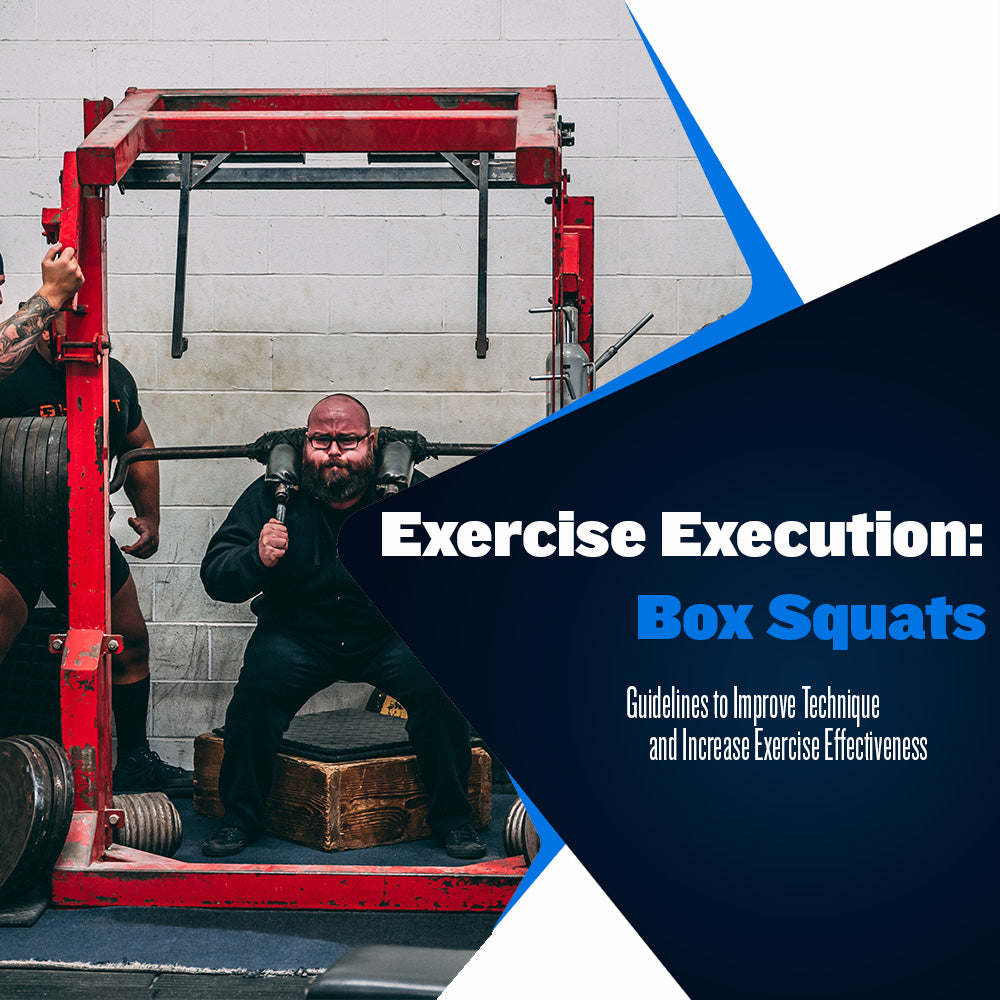Proper Execution of a Box Squat

No matter the sport you compete in, every athlete can benefit from improved lower body strength and muscle development. If you wish to become strong, explosive, and fast, you must develop your legs and trunk as much as possible. Historically, the barbell squat has been the answer to lower body weakness.
However, we know that we must avoid accommodation if we wish to continue making gains in strength and muscle mass. So, what is the optimal choice to pair with squats to prevent accommodation and continue improving lower body strength and composition? The box squat.
Over the years, Westside Barbell has utilized the box squat to create some of the strongest, most explosive squatters and deadlifters. Additionally, we have improved many athletes' strength, speed, and explosive power via the box squat.
All while hearing box squats don't work repeated by those who have failed to reach strength and conditioning enlightenment.
The truth is, box squats work, and they work very well. The trick is understanding how to properly execute the movement and create consistency as far as your form goes. It is a movement that can be tough to learn at first, but it becomes second nature once you figure out how to move to and from the box.
Here are a few tips to help get you on the right track with box squats:
Control Your Descent
The most common mistake that beginners make when finding their optimal box squat form is collapsing to the box. Unlike the conventional squat, where making speed in the eccentric phase leads to improved speed in the concentric phase, there is no speed to be gained dropping to the box.
You will gain hip and pelvis pain, with an increased risk of disc injury. So, as you can see, the movement you make to the box must be performed with control and continuous engagement of all involved muscle groups until you have reached the box.
Start by taking in air and bracing the trunk as much as possible when unracking the barbell. You will push your hips back slightly, which should place your hamstrings and glutes directly over the box. Then, you will break at the knees and squat to the box.
Constant tension is maintained to reduce the chance of unnecessary force absorption once contact with the box has been made.
Ideally, a lifter should create more and more tension as they descend without trying to predict where the box will be. As long as you have set the box in the right spot, it will not grow legs and run away. Lifters who attempt to anticipate where the box will be are more likely to develop poor box squat habits.
Make Full Contact
At Westside, we use the box squat to accomplish two kinds of work; static-overcome-by-dynamic work and relaxed-overcome-by-dynamic work. Without the ability to make proper contact with the box, you cannot achieve either.
You see many people new to box squats (or coached by an individual who has no idea how to box squat) quickly touching the box before reversing course and moving onto the concentric phase of the lift. This is considered poor box squat form.
You want to maintain your controlled descent with no anticipation of where the box is going to be. Once you've made contact with the box, you will relax your hips, glutes, and hamstrings. This is done while keeping tension in the trunk and maintaining optimal squat posture.
Your ability to properly contact the box and disengage the involved lower body muscle groups will ultimately dictate how effective your box squats are.
Explode
Now that you have made a proper descent and made complete contact with the box, it is time to re-engage the disengaged muscle groups and make your move upward.
You hear some folks discuss "rocking back" on the box. This references a shortcut some will take using excessive back and forth torso movement to create momentum to help you exit the box with less resistance.
It can be challenging to identify this by using the eye to evaluate, so be sure a lifter uses momentum to cheat before correcting or changing their execution. Some individuals naturally move in a way that can give the appearance of "rocking" when in reality, it is the motion caused by releasing their hips, glutes, and hamstrings.
An excellent way to teach an athlete how to absorb energy and explode off of a box is through seated box jumps. This helps teach controlled contact with the box, ideal seated posture, and how to relax and engage involved muscle groups from the seated position.
Move With Intent
Once you have perfected your movement, you should be creating as much force as possible to explode from the box. Remember, the effectiveness of any exercise intended to increase the rate of force development relies on the input of the athlete performing the exercise.
Going through the motions will limit both your ability to perform the exercise correctly and the movement's overall effectiveness.
Once you have re-engaged the relaxed muscle groups, you should intend to jump off the box. Of course, you will have a weighted barbell on your back to keep you on the ground, but the intent should be to exert enough force to nearly leave your feet.
This is not to suggest you should leave your feet, however. If the barbell is so light that you're jumping off of the ground with it - increase the weight.
Better Education = Better Execution
The box squat provides the lifter with the stimulus necessary to improve absolute strength or explosive power, depending on how you program them into your exercise rotation. When performed correctly, few exercises outside of conventional squats compare to the benefits associated with this exercise.
Whether you are a powerlifter, athlete, or someone interested in general fitness, box squats are a great tool that you can implement to achieve many different training goals.
Don't allow someone else's poor execution or uneducated opinion to deter you from utilizing this exercise.
An exercise is a tool, the effectiveness of the tool is decided by the knowledge or ability possessed by the individual wielding it. Study proper box squat form, practice with light weights, and increase intensity accordingly.
Where To Learn More
If you want to learn more about box squatting and how to incorporate it into your training, check out our Box Squats And Dynamic Deadlifts 101 downloadable DVD.
This guide covers:
- Bar Setup and Unracking
- Box Squatting
- 5x5 Speed Dynamic Effort Workout
- 5x3 Sumo Deadlift Workout
- 5x3 Conventional Deadlift Workout
And since it's a digital download, you'll get access to it immediately upon purchase - no waiting for shipping.
Check it out here:
In this video Louie Simmons with Joe Rother present you with an in depth tutorial with the aid of practical demo... In this video Louie Simmons with Joe Rother present you with an in depth tutorial with the aid of practical demo...
$10
${ productPrice }
${ originalPriceWithQuantity }
${ productPrice }
$10
${ productPrice }
${ originalPriceWithQuantity }
${ productPrice }
Sources:
Simmons, L. (2015) Special Strength Development for All Sports. Westside Barbell.
Simmons, L. (2007). Westside Barbell Book of Methods. Westside Barbell.
Verkhoshansky, Y., & Siff, M. C. (2009). Supertraining. Verkhoshansky.





